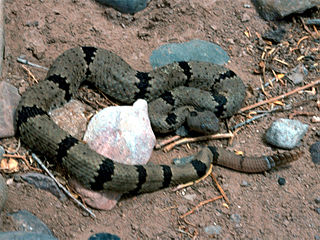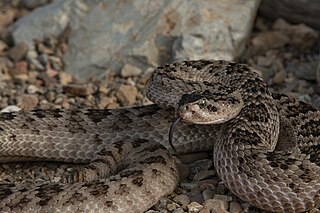
Crotalus scutulatus is known commonly as the Mohave Rattlesnake. Other common English names include Mojave Rattlesnake and, referring specifically to the nominate (northern) subspecies: Northern Mohave Rattlesnake and Mojave Green Rattlesnake, the latter name commonly shortened to the more colloquial “Mojave green”. Campbell and Lamar (2004) supported the English name “Mohave (Mojave) rattlesnake” with some reluctance because so little of the snake’s range lies within the Mojave Desert.

The timber rattlesnake, canebrake rattlesnake, or banded rattlesnake is a species of pit viper endemic to eastern North America. Like all other pit vipers, it is venomous, with a very toxic bite. C. horridus is the only rattlesnake species in most of the populous Northeastern United States and is second only to its relatives to the west, the prairie rattlesnake, as the most northerly distributed venomous snake in North America. No subspecies are currently recognized.

The black-tailed rattlesnake is a venomous pit viper species found in the southwestern United States and Mexico. Four subspecies are currently recognized, including the nominate subspecies described here.

Crotalus lepidus is a venomous pit viper species found in the southwestern United States and northern central Mexico. Four subspecies are currently recognized, including the nominate subspecies described here.

Crotalus basiliscus, known as the Mexican west coast rattlesnake, Mexican green rattler, and also by other names, is a species of pit viper in the family Viperidae. The species is endemic to western Mexico. Like all other pit vipers, it is venomous. The specific name, basiliscus, is derived from the Greek word for king, βασιλισκος, and alludes to this snake's large size and potent venom. No subspecies are currently recognized.

Crotalus helleri or Crotalus oreganus helleri, also known commonly as the Southern Pacific rattlesnake, the black diamond rattlesnake, and by several other common names, is a pit viper species or subspecies found in southwestern California and south into Baja California, Mexico, that is known for its regional variety of dangerous venom types. It is sometimes considered a subspecies of Crotalus oreganus.

The western diamondback rattlesnake or Texas diamond-back is a rattlesnake species and member of the viper family, found in the southwestern United States and Mexico. Like all other rattlesnakes and all other vipers, it is venomous. It is likely responsible for the majority of snakebite fatalities in northern Mexico and the greatest number of snakebites in the U.S. No subspecies are currently recognized.

Crotalus viridis is a venomous pit viper species native to the western United States, southwestern Canada, and northern Mexico. Currently, two subspecies are recognized, including the prairie rattlesnake, the nominate subspecies, and the Hopi rattlesnake.

Crotalus mitchellii is a venomous pit viper species in the family Viperidae. The species is endemic to the Southwestern United States and adjacent northern Mexico. The species was named in honor of Silas Weir Mitchell (1829–1914), an American medical doctor who also studied rattlesnake venoms. Five subspecies are currently recognized, including the nominate subspecies described here.

The Santa Catalina rattlesnake is a species of pit viper endemic to Isla Santa Catalina in the Gulf of California just off the east coast of the state of Baja California Sur, Mexico. Like all other pit vipers, it is venomous. No subspecies are currently recognized. A relatively small and slender species, its most distinctive characteristic is that it lacks a rattle. They are also a generally nocturnal species. Though the species is classified as Critically Endangered on the IUCN Red List, there are few efforts for the snake's conservation.

Crotalus ravus, commonly known as the Mexican pigmy rattlesnake or Mexican pygmy rattlesnake, is a venomous pit viper species, found only in Mexico. Three subspecies are currently recognized.

Crotalus viridis nuntius is a venomous pit viper subspecies native primarily to the desert plateau of the northeastern portion of the American state of Arizona, but also ranges into northwestern New Mexico. Named for the Native American Hopi tribe, which inhabits the region, its range overlaps that of the nominate subspecies and some interbreeding is believed to occur. The taxonomy of the C. viridis group is a matter of debate, many considering the various subspecies to be nothing more than locality variations.

Crotalus lepidus klauberi is a venomous pitviper subspecies native to the southwestern United States and adjacent northern Mexico.

Crotalus durissus, known as the South American rattlesnake, tropical rattlesnake, and by other names, is a highly venomous pit viper species found in South America. It is the most widely distributed member of its genus. Currently, seven subspecies are recognized.

Crotalus oreganus, commonly known as the Western rattlesnake or northern Pacific rattlesnake, is a venomous pit viper species found in western North America from the Baja California Peninsula to the southern interior of British Columbia.

The Great Basin rattlesnake is a venomous pit viper species found in the Great Basin region of the United States.

Crotalus stejnegeri, commonly known as the Sinaloan long-tailed rattlesnake or just long-tailed rattlesnake, is a venomous pit viper species in the family Viperidae. The species is native to western Mexico. There are no recognized subspecies.

Crotalus scutulatus salvini, commonly known as the Huamantlan rattlesnake, is a venomous pit viper, currently classified as a subspecies of C. scutulatus that is found in mainland Mexico, at the southern end of the distribution of C. scutulatus. The subspecific epithet honors the nineteenth century British naturalist Osbert Salvin.
Crotalus enyo furvus, also known as the Rosario rattlesnake or the dusky Baja California rattlesnake, is a subspecies of Baja California rattlesnake, a kind of venomous pit viper. It is named after the latin 'furvus' meaning 'dark complexion' or 'swarthy', referring to the colouration of the subspecies. It is found on the San Quentin Plain in Baja California del Norte - due to the area's restricted and largely inaccessible habitat not much is known about the subspecies.


















